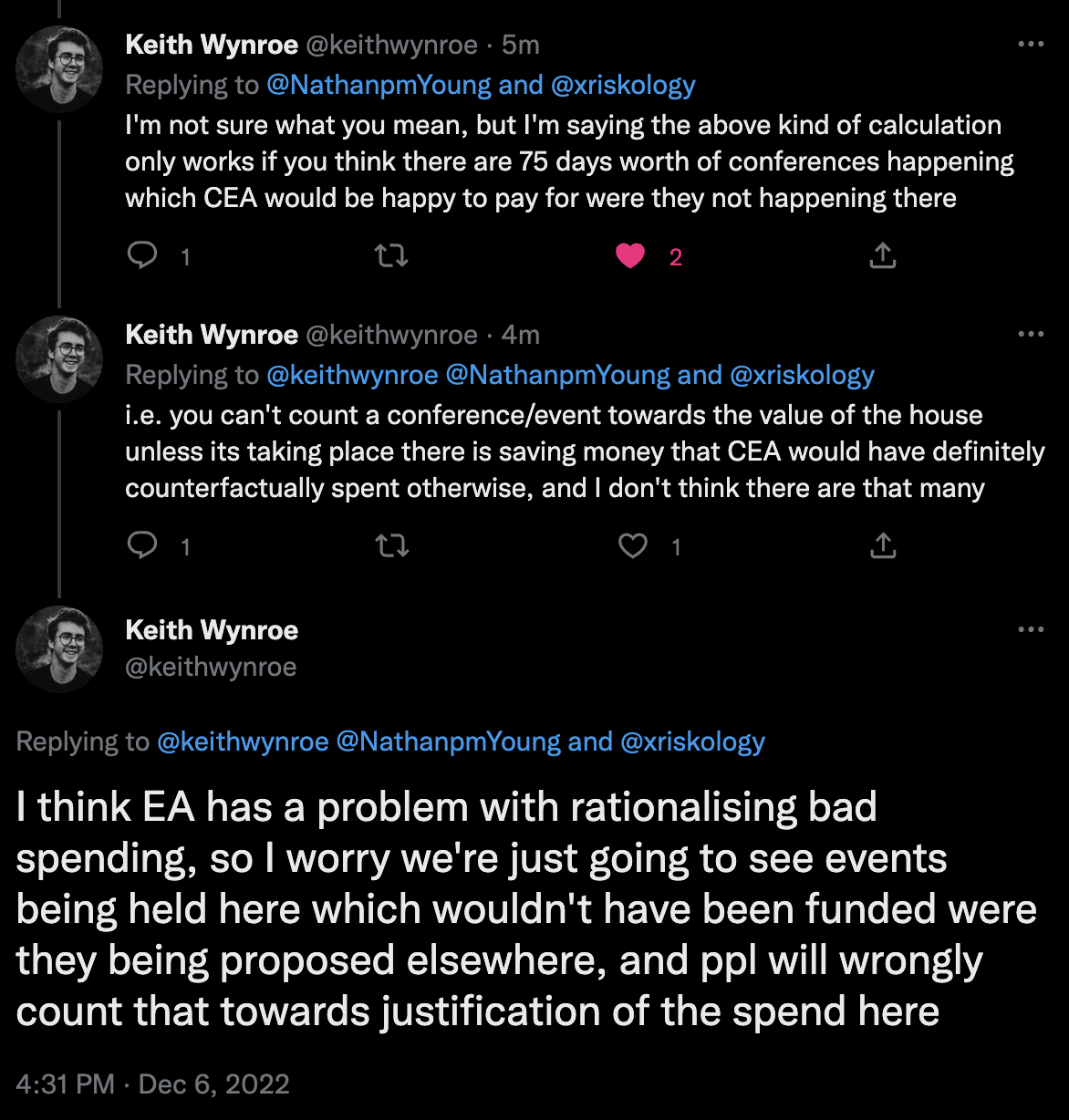Edit to add (9/1/2023): This post was written quickly and I judged things prematurely. I also regret not reaching out to Effective Ventures before posting it. Regarding my current opinion on the Abbey: I don't have anything really useful to say that isn't mentioned by others. The goal of this post was to ask a question and gather information, mostly because I was very surprised. I don't have a strong opinion on the purchase anymore and the ones I have are with high uncertainty. More thoughts in my case for transparent spending.
Yesterday morning I woke up and saw this tweet by Émile Torres: https://twitter.com/xriskology/status/1599511179738505216
I was shocked, angry and upset at first. Especially since it appears that the estate was for sale last year for 15 million pounds: https://twitter.com/RhiannonDauster/status/1599539148565934086
I'm not a big fan of Émile's writing and how they often misrepresent the EA movement. But that's not what this question is about, because they do raise a good point here: Why did CEA buy this property? My trust in CEA has been a bit shaky lately, and this doesn't help.
Apparently it was already mentioned in the New Yorker piece: https://www.newyorker.com/magazine/2022/08/15/the-reluctant-prophet-of-effective-altruism#:~:text=Last year%2C the Centre for Effective Altruism bought Wytham Abbey%2C a palatial estate near Oxford%2C built in 1480. Money%2C which no longer seemed an object%2C was increasingly being reinvested in the community itself.
"Last year, the Centre for Effective Altruism bought Wytham Abbey, a palatial estate near Oxford, built in 1480. Money, which no longer seemed an object, was increasingly being reinvested in the community itself."
For some reason I glanced over it at the time, or I just didn't realize the seriousness of it.
Upon more research, I came across this comment by Shakeel Hashim: "In April, Effective Ventures purchased Wytham Abbey and some land around it (but <1% of the 2,500 acre estate you're suggesting). Wytham is in the process of being established as a convening centre to run workshops and meetings that bring together people to think seriously about how to address important problems in the world. The vision is modelled on traditional specialist conference centres, e.g. Oberwolfach, The Rockefeller Foundation Bellagio Center or the Brocher Foundation.
The purchase was made from a large grant made specifically for this. There was no money from FTX or affiliated individuals or organizations." https://forum.effectivealtruism.org/posts/Et7oPMu6czhEd8ExW/why-you-re-not-hearing-as-much-from-ea-orgs-as-you-d-like?commentId=uRDZKw24mYe2NP4eq
I'm very relieved to hear money from individual donors wasn't used. And the <1% suggests 15 million pounds perhaps wasn't spent. Still, I'd love to hear and understand more about this project and why CEA thinks it's cost-effective. What is the EV calculation behind it?
Like the New Yorker piece points out, with more funding there has been a lot of spending within the movement itself. And that's fine, great even. This way more outreach can be done and the movement can grow. But we don't want to be too self-serving, and I'm scared too much of this thinking will lead to rationalizing lavish expenses (and I'm afraid this is already happening). There needs to be more transparency behind big expenses.
Edit to add: If this expense has been made a while back, why not announce it then?


Thank you for the explanation, I understand your point of view better now. That being said, the way you explained still reads to me more as Owen and his team running a project (albeit with a high degree of autonomy) for EVF than EVF acting a facilitator. But in either case, EVF was ultimate decision maker and they are the organization that bought the building. I don't think the degree of separation is significant enough to say that this was not an EVF decision or that EVF is not responsible for it.
I agree with your points about EVF micromanaging the projects of its subsidiaries under threat of pulling out being undesirable, but I don't think they apply very well here. This is because a) the decision was not whether org X's action was a cost effective ot reasonable one but whether this action should be taken under the stewardship and sponsorship of EVF in the first place, b) because it was a very high stakes decision simply in terms of initial and ongoing costs, and c) the degree of involvement that EVF will have seems to be enough that this should be treated as an EVF project regardless. The last point is the one I'm most unsure about and is based on a lot of comments in this thread justifying the choice of Oxford as a venue because of the convenience for CEA staff, although I'm unclear how much of that is based on actual information about how the venue will be used versus speculation from commenters.
Additionally, if this is a situation where the Abbey is going to be run independently from EVF and with a dedicated team, I think further justification of Oxford should be necessary, both because of the high cost of the area and because if how difficult it is to get UK visas (which would arguably diminish the expected value as it limits the use and the range of activities- I'll admit to some bias here because I've had a number of friends and colleagues get rejected for UK visas for legitimate work and education travel for workshops and conferences over the past couple months and I'm not certain how common that it is. Still, it seems like selecting somewhere in the Schengen zone or Eastern Europe where you can still have the "pleasant surroundings" for a cheaper price and with less economic and time costs involved in being able to actually get there might have been a good thing to consider)